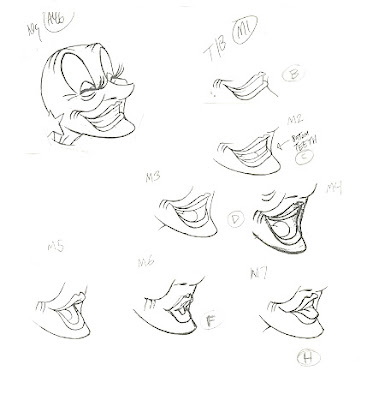It was 1927 when Warner Bros. released the first live action film, "The Jazz Singer" and introduced audiences to sound in the form of "talking pictures". And in the Summer of 1928, Walt Disney's "Steamboat Willie" was the first to introduced audiences to lip sync sound, sound effects and music in an animated cartoon.
For this post, i would like to take you step by step through the process and give you some tips along the way.
Here's a Lip Sync Chart of the Mouth positions and what sounds each mouth can make.
This character's closed mouth would be an "A" mouth, which would be a closed smile with lips, no teeth. In this scene, the character never used an "A" mouth, since she was always smiling with her teeth. Below you can see her mouth positions.
Before you begin reading your sound track, you need to determine your character's mouth positions will work. This would be a model sheet showing the various mouth positions.
Before you start animating a character, you need to create a series of modelsheets showing the character in various positions, etc. Check this previous post all about modelsheets.
Using the mouth positions modelsheet will help you determine what mouth to animate once you have filled out your X sheet. The mouth positions should have both happy, sad or angry mouths. These modelsheets make sure everyone is drawing the character's mouth expression in the same way.
I have given a few demos about how to "read" or breakdown a sound track and its like watching someone knit a sweater. By the time I finish showing the process, I ask if there are any questions and no one does. I feel like this something the students need to do on their own, make mistakes and learn from them.
Here's a way to set up a lip sync scene where you are placing the mouth positions on top of the rest of the character's head.
Using the mouth positions modelsheet will help you determine what mouth to animate once you have filled out your X sheet. The mouth positions should have both happy, sad or angry mouths. These modelsheets make sure everyone is drawing the character's mouth expression in the same way.
I have given a few demos about how to "read" or breakdown a sound track and its like watching someone knit a sweater. By the time I finish showing the process, I ask if there are any questions and no one does. I feel like this something the students need to do on their own, make mistakes and learn from them.
Here's a way to set up a lip sync scene where you are placing the mouth positions on top of the rest of the character's head.








Hi Jim,
ReplyDeleteThanks for another great article! I especially liked your table of mouth shapes. The art style you used makes it really easy to understand the essence of what each mouth shape represents.
Side note: I can't see the video you mention.
I'm currently trying my hand at limited animation, using only the basic mouth shapes without additional in-betweens. The result looks good for the most part, but sometimes there are stretches where I feel forced to use a single mouth shape for a second or so, making the mouth look frozen during that time.
What happens is that the dialog contains multiple "EE" vowels (for which I use the B shape). The consonants between these vowels are either clenched-teeth consonants (for which I also use the B shape) or "flexible" ones (for which I use the previous or following mouth shape -- which are also Bs).
Here are some made-up examples:
Deedee seized his keys. -> BBBBB...
He seeks the easy deal. -> BBBBB...
Do you see a better way for animating cases like these?
Best regards,
Daniel
Thanks Daniel,
DeleteGreat Question to a possible problem using the same mouth position all in a row. One possible solution would be to figure out how to move your character into
a pose during these lines. I've learned that its hard to hit a moving target and a slight movement away from stationary position. Adding a gesture that helps sells what is being said will work to.
The C mouth can also be used when using a lot of B mouth sounds. This is a tricky bit, but you might have to experiment to solve the problem, test it different ways to find the best. Your character has a head that can move and a face that can change into different expressions. Hope that helps, Jim
Don't miss next Watchcat Wednesday... http://watchcatfiles.blogspot.com
Hi Jim,
DeleteThank you for your explanation! It makes sense to me that the most elegant approach would be to distract from the static mouth by introducing a different kind of movement. However, since I'm working with some technical limitations, I'll explore your other suggestion of using C for some of the B shapes.
Best regards,
Daniel
Hi Jim,
DeleteThanks again for your advice! Sparingly using C instead of B works great! It doesn't look "wrong" at all (I was afraid it would), and it keeps the lips busy so they don't appear static.
Best,
Daniel